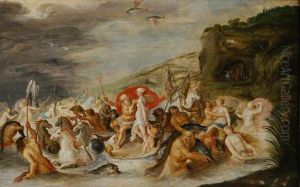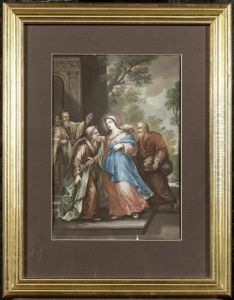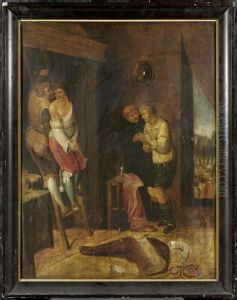Franz Franken Der Jungere Paintings
Frans Francken the Younger was a Flemish painter and a member of the renowned Francken family of artists, which played a significant role in the development of Flemish art during the 16th and 17th centuries. Born in 1588 in Antwerp, Belgium, Frans was the son of Frans Francken the Elder and Elisabeth Mertens. He was the most famous member of the Francken family and his brothers, Hieronymus and Ambrosius Francken II, were also painters, but they did not achieve the same level of fame as Frans the Younger.
Frans Francken the Younger's early training was under the guidance of his father, Frans Francken the Elder, who was a notable artist in his own right. He became a master in the Antwerp Guild of Saint Luke in 1605. Throughout his career, Francken developed a versatile style, which helped him to become one of the most prominent painters in Antwerp after Peter Paul Rubens. His works were varied, including historical themes, genre scenes, witchcraft themes, and allegories. He is particularly well-known for his small cabinet pictures, which often depicted art galleries and collections.
Francken played a significant role in the development of the genre of gallery paintings, which depicted art collections within an interior setting. These works were sought after by wealthy art collectors of the time, who enjoyed seeing their collections immortalized in paint. Francken's skill in painting intricate details made him particularly adept at this genre.
Frans Francken the Younger's style was characterized by a dynamic and ornate quality. He was known for his use of bright colors, and although he was influenced by the Baroque style of painting, his work also retained many elements of the Mannerist tradition. His compositions were complex, yet harmonious, and he had a talent for depicting figures and their interactions within a space.
Throughout his career, he collaborated with other prominent artists of his time, such as Peter Paul Rubens and Anthony van Dyck. His influence extended beyond his immediate family, as he also trained a number of apprentices who would go on to become successful artists.
Francken's work was in high demand during his lifetime and continues to be highly regarded. His paintings can be found in major museums and art collections worldwide. Frans Francken the Younger died in Antwerp in 1642, leaving behind a legacy that would influence Flemish art for years to come.


